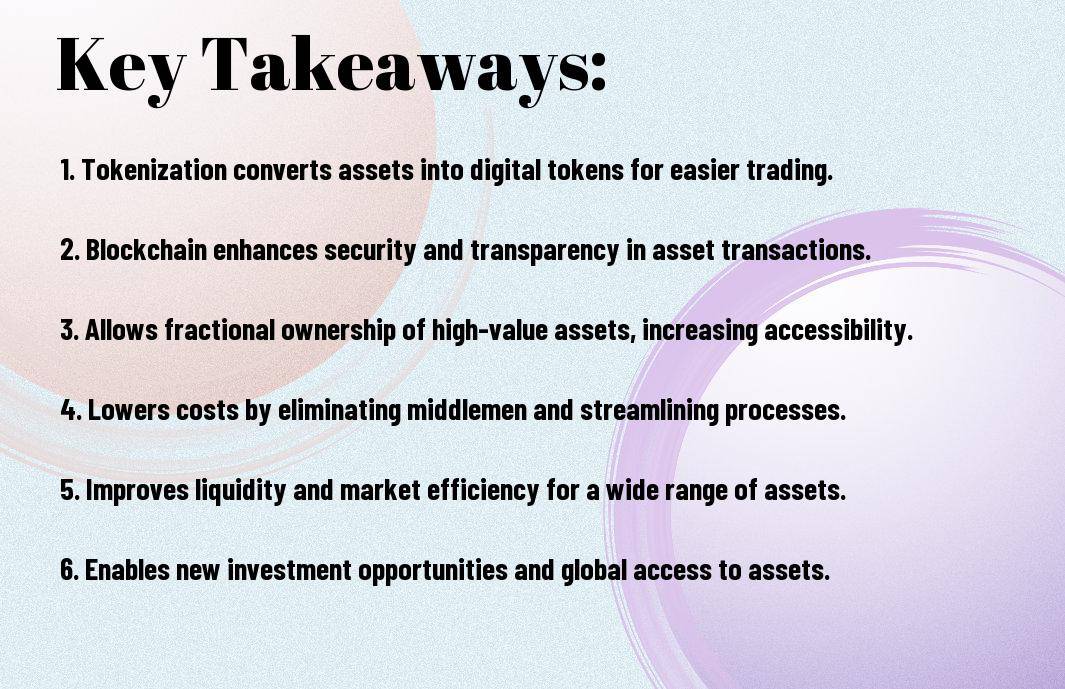Tokenization is revolutionizing the way traditional assets are being transformed into digital entities through blockchain technology. This process involves converting physical assets such as real estate, art, or even stocks into digital tokens, enabling fractional ownership and instant transferability. Tokenization offers a myriad of benefits including increased liquidity, reduced transaction costs, and improved accessibility to a wider pool of investors. However, with these advantages also come challenges such as regulatory compliance, security risks, and the potential for fraudulent activities.
Key Takeaways:
- Tokenization is transforming traditional assets into digital tokens that can be easily traded on blockchain platforms.
- Through tokenization, assets like real estate, art, and commodities can be divided into smaller fractions, allowing broader investment opportunities.
- Blockchain technology ensures transparency, security, and immutability of asset ownership and transactions.
- Tokenization reduces middlemen, increases liquidity, and lowers transaction costs in asset trading.
- Regulations around tokenized assets are evolving to provide legal clarity and protect investors in this emerging market.
- Investors should conduct thorough research on tokenized assets platforms, issuers, and regulations to make informed investment decisions.
- Tokenization has the potential to democratize access to investment opportunities and reshape traditional financial markets.


The Evolution of Tokenization
Some Asset Tokenization: Basics, Benefits & Blockchain has transformed the way we view and interact with assets. Through the use of blockchain technology, the process of representing real-world assets digitally has ushered in a new era of financial innovation. Tokenization has enabled the fractional ownership of assets, opening up investment opportunities to a broader range of investors.
Historical Context and Traditional Assets
With the advent of blockchain technology, traditional assets such as real estate, fine art, and commodities can now be tokenized and traded on digital asset platforms. This shift towards digitization adds liquidity to traditionally illiquid assets, allowing for faster and more efficient transactions. Tokenization also enhances transparency and security in asset ownership, reducing the risk of fraud and disputes.
The Shift Toward Digital Assets
Tokenization has paved the way for the digitization of a wide range of assets, including securities, collectibles, and intellectual property. This shift towards digital assets has revolutionized the way we perceive value and ownership, as blockchain technology ensures immutable records of ownership and transaction history. Digital assets also offer instant global accessibility, allowing investors to diversify their portfolios with ease.
Understanding Blockchain’s Role in Tokenization
Basics of Blockchain Technology
For centuries, traditional ledgers have been used to record transactions. However, these ledgers are susceptible to human error, fraud, and tampering. Blockchains change the game by offering a decentralized, secure, and transparent way to record transactions. A blockchain is a distributed ledger that stores transactional records, or ‘blocks’, in a chronological chain. Each block is linked to the previous one, forming a secure and immutable record of transactions.
How Blockchain Enables Tokenization
Any asset, whether physical or digital, can be tokenized on a blockchain. Tokenization involves converting the rights to an asset into a digital token that can be traded or transferred on a blockchain network. By leveraging blockchain technology, tokenization enables fractional ownership, increased liquidity, and streamlined transfer of assets. This revolutionary process opens up new investment opportunities and democratizes access to assets that were previously illiquid or exclusive.
A blockchain acts as the underlying infrastructure that powers tokenization. It provides a secure and transparent platform for issuing, managing, and trading digital tokens representing various assets. By utilizing smart contracts, agreements coded on the blockchain, tokenized assets can be exchanged automatically when predefined conditions are met. This automated process reduces the need for intermediaries, minimizes transaction costs, and enhances the efficiency of asset management.
Types of Assets that Can Be Tokenized
Once again, let’s explore the various types of assets that can be tokenized using blockchain technology. By tokenizing assets, traditional assets are converted into digital tokens that are secured by smart contracts on a blockchain network.
| Real Estate | Financial Instruments |
| Art and Collectibles | Intellectual Property and Royalties |
| Physical Assets |
Real Estate Tokenization
On the forefront of tokenization is the real estate sector. By tokenizing real estate assets, investors can now own fractions of properties, opening up opportunities for small-scale investors to participate in the real estate market. Tokenized real estate offers increased liquidity and easier access to a traditionally illiquid asset class.
Tokenization of Financial Instruments
Tokenization of financial instruments such as stocks, bonds, and commodities is revolutionizing traditional financial markets. By tokenizing these assets, transactions become more efficient, transparent, and accessible. These tokenized assets can be traded 24/7 on blockchain exchanges, eliminating intermediaries and reducing costs.
That being said, tokenization of financial instruments also brings regulatory challenges and concerns regarding security and compliance. It is crucial for tokenized assets to comply with existing financial regulations to ensure investor protection and market integrity.
Art and Collectibles
Tokenization has disrupted the art and collectibles market by enabling fractional ownership of valuable pieces. Collectors can now own a share of a masterpiece, making art investment more accessible and liquid. Additionally, blockchain technology ensures provenance and authenticity, addressing the issue of counterfeit art.
Understanding the value and scarcity of art and collectibles, tokenization allows investors to diversify their portfolios and participate in an exclusive market that was previously reserved for the ultra-wealthy.
Intellectual Property and Royalties
Property
Tokenized intellectual property rights and royalties offer creators a new way to monetize their work. Musicians, writers, and artists can tokenize their creations, providing fans and investors with the opportunity to earn royalties by owning a portion of the intellectual property. This innovative approach disrupts the traditional royalty distribution system, ensuring fair compensation for creators.
Tokenization of Physical Assets
Assets
Tokenization of physical assets like precious metals, real estate, and commodities unlocks opportunities for fractional ownership and increased liquidity. By tokenizing physical assets, investors can diversify their portfolios and access alternative investment opportunities that were previously restricted to institutional investors. Tokenization also enhances asset traceability and transparency, reducing the risk of fraud and enhancing trust in the market.
Benefits of Tokenizing Assets
Increased Liquidity and Fractional Ownership
The tokenization of assets has revolutionized the traditional investment landscape by offering increased liquidity and fractional ownership opportunities. The ability to divide assets into smaller, more affordable units allows investors to participate in markets that were previously inaccessible due to high entry barriers. This fractional ownership model also enhances liquidity as investors can buy and sell tokens on secondary markets more easily, enabling them to exit their investments whenever needed.
Transparency and Reduced Fraud
The blockchain technology underlying asset tokenization provides Reduced opportunities for fraud and enhances transparency in transactions. Each token represents a unique digital record that is immutable and tamper-proof, ensuring that the ownership and transaction history of the asset are securely stored and easily verifiable. Ownership transfer of tokenized assets is executed through smart contracts, eliminating the need for intermediaries and reducing the risk of fraudulent activities.
Fraudulent activities such as double spending and counterfeit assets are significantly minimized through the transparent nature of blockchain technology, where every transaction is recorded and visible to all network participants. Reduced operational costs associated with traditional asset transfers and the increased trust resulting from transparent transactions are key benefits of embracing tokenization in asset management.
Enhanced Market Efficiency
Assets are tokenized for improved market efficiency, allowing for faster settlement times and reduced operational complexities in asset trading. By representing traditional assets as digital tokens, the process of verifying ownership, transferring assets, and conducting transactions is streamlined through automated smart contracts. This increased efficiency benefits both investors and asset issuers by reducing transaction costs and minimizing the time required for asset transfers.
Accessibility for Smaller Investors
Tokenizing assets enables smaller investors to participate in markets that were previously dominated by institutional players. By lowering the entry barriers and fractionalizing ownership, retail investors can diversify their portfolios with smaller investments across a range of asset classes. This democratization of investment opportunities empowers a broader spectrum of investors to access traditional and alternative assets through tokenization platforms.
Benefits of accessibility for smaller investors include increased portfolio diversification, exposure to new asset classes, and the ability to invest in previously illiquid markets. By breaking down traditional assets into digital tokens, smaller investors can benefit from the potential returns and portfolio growth opportunities that were once reserved for larger institutional players.
The Process of Tokenization
Pre-Tokenization Considerations and Compliance
Not every asset is suitable for tokenization. It is crucial to consider the legal and regulatory requirements before proceeding with the tokenization process. Factors such as the type of asset, jurisdiction, and target investors should be thoroughly evaluated to ensure compliance with applicable laws.
Creating the Digital Token
An necessary step in the tokenization process is creating the digital token. This involves representing the asset on the blockchain in a digital form. PreTokenization considerations include determining the token standards, such as ERC-20 or ERC-721, and defining the smart contract terms.
This digital representation enables the asset to be divided into fractional shares, making it more accessible to a wider range of investors. Additionally, the smart contract governs the token issuance and ensures compliance with the predefined rules and regulations.
Token Distribution and Exchange Listing
To ensure liquidity and market access for investors, the token distribution and exchange listing are crucial steps in the tokenization process. Tokens can be distributed through private placements, public offerings, or crowdfunding platforms. Exchange listing on reputable cryptocurrency exchanges enables investors to buy, sell, and trade the tokens.
To increase visibility and attract a broader investor base, tokens can be listed on multiple exchanges. This diversification reduces the risk of market manipulation and enhances the overall liquidity of the asset.
Post-Tokenization Asset Management
Exchange listings and token distribution are just the beginning of post-tokenization asset management. Compliance with ongoing regulatory requirements, market monitoring, and investor relations are critical aspects to consider. Efficient asset management strategies help maintain the asset’s value and ensure investor confidence in the tokenized asset.
Token liquidity, market demand, and regulatory changes should be continuously monitored to adapt to the evolving market conditions. Compliance with securities laws, anti-money laundering regulations, and investor protection measures is paramount for sustained success in the tokenized asset space.

Challenges in Asset Tokenization
Regulatory Hurdles and Legal Framework
Unlike traditional financial assets, tokenized assets face regulatory hurdles and legal challenges due to the evolving nature of blockchain technology. One of the primary concerns is the lack of a standardized regulatory framework to govern the issuance and trading of tokenized assets. Regulatory bodies worldwide are still grappling with how to classify and regulate these digital assets, leading to uncertainty and inconsistency in the legal landscape.
Technological Barriers and Security Issues
Legal compliance aside, technological barriers and security issues present significant challenges in the asset tokenization space. One major technological barrier is the scalability of blockchain networks to handle a large volume of tokenized assets efficiently. Moreover, security concerns such as the vulnerability of smart contracts to hacks and breaches pose risks to the integrity and trustworthiness of tokenized assets.
Technological advancements like the integration of more robust security protocols and scalable blockchain solutions are imperative to address these challenges and ensure the successful tokenization of assets.
Market Adoption and Public Perception
Challenges in market adoption and public perception also hinder the widespread acceptance of asset tokenization. One of the key challenges is the limited understanding and awareness of tokenized assets among investors and the general public. The lack of education and transparency surrounding tokenization processes and benefits contributes to skepticism and reluctance to embrace this innovative financial technology.
Adoption of asset tokenization requires concerted efforts from industry stakeholders to educate the market, build trust through transparent practices, and showcase the tangible benefits of digitizing assets through blockchain technology.

The Future of Tokenization and Blockchain
Predictions for Asset Tokenization
With the growth of blockchain technology and tokenization, the future holds exciting possibilities for asset digitization. Predictions suggest that traditional assets such as real estate, fine art, and even intellectual property will become tokenized. This will democratize access to investments, allowing a wider range of investors to participate in markets that were previously inaccessible.
Innovations on the Horizon
Horizon advancements in tokenization and blockchain technology could revolutionize the way we think about ownership and value. Smart contracts will enable programmable assets, allowing for automated transactions and self-executing agreements. Interoperability between different blockchain networks will further streamline the tokenization process, making it more efficient and cost-effective.
Plus, with the rise of decentralized finance (DeFi), we may see innovative financial products and services that were previously unimaginable. This could potentially disrupt traditional banking systems and empower individuals to have more control over their finances.
Impact on Traditional Finance and Emerging Markets
Tokenization has the potential to transform traditional finance by reducing operational costs, increasing transparency, and improving liquidity. By digitizing assets, issuers can fractionalize ownership, opening up new investment opportunities to a global audience. Emerging markets, in particular, stand to benefit from this increased access to capital and liquidity.
Innovations in blockchain and tokenization could also address issues of financial inclusion by providing secure and affordable financial services to underserved populations. This could help bridge the gap between the unbanked and traditional financial systems, fostering economic growth and stability.
Summing up
Following this deep probe tokenization and how assets are being transformed with blockchain technology, it is evident that this innovative approach has the potential to revolutionize traditional finance and investment. By tokenizing assets, real-world assets are becoming more accessible, liquid, and efficient for investors. This digitization process also opens up new opportunities for fractional ownership, automated compliance, and increased transparency in asset management.
In the aggregate, the adoption of blockchain technology for tokenization is not only reshaping the way assets are represented and traded but also disrupting the traditional financial industry by democratizing access to investment opportunities. As this trend continues to gain momentum, it is crucial for investors, regulators, and industry players to understand and adapt to the evolving landscape of digitized assets to fully harness the benefits of this digital transformation.
FAQ
Q: What is tokenization?
A: Tokenization is the process of converting real-world assets into digital tokens on a blockchain. These tokens represent ownership of the underlying asset and can be traded or transferred digitally.
Q: How does tokenization work?
A: Tokenization works by creating a digital representation of an asset on a blockchain. This is done by issuing tokens that are linked to the asset, allowing for ownership to be transferred securely and efficiently.
Q: What are the benefits of tokenization?
A: Tokenization offers increased liquidity, fractional ownership, 24/7 trading, reduced transaction costs, and transparency in asset ownership and transfer.
Q: What assets can be tokenized?
A: Virtually any asset can be tokenized, including real estate, artworks, commodities, stocks, bonds, and even intellectual property rights.
Q: Is tokenization secure?
A: Yes, tokenization on a blockchain provides security through encryption, decentralization, immutability, and transparency, making it highly resistant to fraud and tampering.
Q: How is tokenization regulated?
A: Tokenization is subject to regulations depending on the jurisdiction and the type of asset being tokenized. It is important to comply with securities laws and regulations to ensure legal compliance.
Q: What is the future of tokenization?
A: The future of tokenization is promising, with potential applications in a wide range of industries, including finance, real estate, art, and supply chain management. As blockchain technology continues to evolve, the scope and impact of tokenization are expected to grow exponentially.



